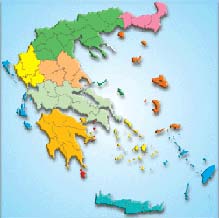
Please click on the map,
the region you want to visit |
|
|
|
|
| |
|
 |
Images of Ioannina |
|
  Ioannina city is built on the shores of Pamvotida Lake, combining beauty with charm, history and modern city. Ioannina city is built on the shores of Pamvotida Lake, combining beauty with charm, history and modern city.
It's an ideal base for many day trips in the surrounding areas: Zagorochoria, Mastorochoria, Katsanochoria, Grammenochoria, Kourentochoria, Metsovo, Ntouskara, National Park of Vikos-Aoos, Pindos National Park (Valia Calda), etc.
|
There are many options for entertainment and accommodation in the city of Ioannina and in the villages with the traditional accommodations.
Walk along the banks of the lake, enjoy a coffee in one of the many cafes in the
area and taste great local, traditional and international cuisine in one of the taverns or the restaurants in the city. |
Do not forget to try pies, pastries, cheeses and wines.
Wander through the numerous souvenir shops and shop silversmith items since the place has a long tradition in them.
Distances: from Athens, 435 km, from Thessaloniki, 350 km, from Igoumenitsa 79 km. |
 |
The Castle of Ioannina |
|
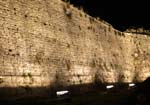 The castle is located next to the lake, in the center of the town, and its larger part is a work of the era of the Ottoman rule. The castle is located next to the lake, in the center of the town, and its larger part is a work of the era of the Ottoman rule.
Browse the castle, bob the hills, the loopholes and the picturesque streets of the village.
Inside the castle there are: the inner citadel (Its Kale) with buildings, which are the Municipal and the Byzantine Museum and the settlement of the old city.
It has 4 entrances, two on the main road and two on the lakeside road.
Its length is about 2000 meters and the width 10 m. At the time of Ali Pasha, it met his heyday when it became a major administrative center of Ottoman Greece. |
 |
Municipal Museum |
|
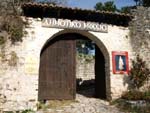 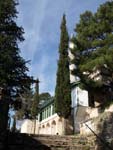 Municipal Museum
The Aslan Mosque in the castle houses now the Municipal Museum. It was built in 1618 by Aslan Pasha, after the failed revolution of Dionysius the Philosopher in 1611. Municipal Museum
The Aslan Mosque in the castle houses now the Municipal Museum. It was built in 1618 by Aslan Pasha, after the failed revolution of Dionysius the Philosopher in 1611.
Around the mosque there are other buildings that constitute a single cluster of Muslim.
The exhibits are divided, according to their origin, into Greek, Hebrew and Turkish.
In a hall of the museum with the Greek element, traditional Greek costumes are displayed:
•Courtly costume of Ioannina: embroidered silk shirt, velvet dress, embroidered lining, embroidered fez, fabric belt with an iron buckle.
• 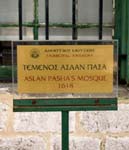 Souli costume: white cotton shirt, apron decorated with sequins, black wool coat, shoes, rustic shoes, buckle. Souli costume: white cotton shirt, apron decorated with sequins, black wool coat, shoes, rustic shoes, buckle.
• Pogoni costume: white cotton shirt, coat from wool, silk coat, apron, yellow scarf with floral decoration hung from waist, headband, jewelry: cervical, Kimeri.
• Sarakarsanon costume: wool jabot, cape, skirt or dress, handmade shoes, rustic shoes, headband - kerchief, buckle.
• Zagoria costume: silk shirt, black dress, red apron with colorful embroidery, coat, black scarf stamped with floral decoration, jewelry: Chain, metal belt buckle with iron technique.
There are also weapons of late 18th - 19th century:
• Firearms: Firelocks, blunderbuss, harquebus, pistols
• Weapons: sabers, broadswords, knives, books
•Arm Accessories: bullet belts, gunpowder stick
All exhibits in museum characterize the era where the three communities co-existed (Greek, Hebrew, Turkish). |
 |
Byzantine Museum |
|
 The building was built in 1958 by the Greek army and it was used as a Royal Pavilion. Before this, the military hospital was in this place, which was built after 1870 in the courtyard of Seragios. The building was built in 1958 by the Greek army and it was used as a Royal Pavilion. Before this, the military hospital was in this place, which was built after 1870 in the courtyard of Seragios.
Its repair and the conversion into a museum became progressively from 1986 to 1995.
 It is located in the large indoor Citadel (Its Kale) of the castle and contains a set of buildings: It is located in the large indoor Citadel (Its Kale) of the castle and contains a set of buildings:
• The Treasury. Today, this building accommodates the collection of the Museum of Silversmithing.
• The kitchen's building. It operates as a snack-bar.
• The tomb of Ali Pasha. On the northwestern side of Fethichie Mosque, is the family tomb of Ali Pasha is saved. Here, his headless body was buried in 1822. In the same tomb, in 1809, had been buried his wife and one of his sons.
The current fence constructed in 1999, on the initiative of the Association of ancient friends of Ioannina and the outlay of Philip's endowment and is a copy of the former fence that was removed in 1943.
• The gunpowder. The building is located west of Fethichie Mosque on the eastern part of the internal citadel (Its Kale). It was used by the army of Ali Pasha as a munitions storage area (gunpowder).
It is an oblong domed single-room building, which has been recently maintained by the 8th Byzantine Antiquities Association and is going to be used as a place of periodic exhibitions and of additional functions of the Museum.
 • The Fethichie Mosque. In this area is considered to be located the place of the Byzantine cathedral of Archangel Michael, patron saint of the city, built by the lord of the Castle, Michael A' (1205-1215). After 1430, it was built, next to the ruined cathedral, the first metziti (wooden mosque) by the name Fethichie Mosque, which means the mosque of conquest. • The Fethichie Mosque. In this area is considered to be located the place of the Byzantine cathedral of Archangel Michael, patron saint of the city, built by the lord of the Castle, Michael A' (1205-1215). After 1430, it was built, next to the ruined cathedral, the first metziti (wooden mosque) by the name Fethichie Mosque, which means the mosque of conquest.
In 1611, after the failed revolt of Dionysius the Philosopher and the eviction of Christians from the castle, a stone of leaded- roof erected with a spindly minaret.
In 1795, Ali Pasha rebuilds it, giving to it its present form: a square base, octagonal roof, vaulted ceiling. The facade and the east side have rebuilt by the Greek army. Outside, at the north and east side, the floor of the loggia is still preserved. Internally, parts of marble pillars of a Byzantine iconostasis that are built-in at the left jambs of the Mihrab, and the abstract painting of the dome are preserved too.
The latest repair work done in 1990-1991 by the 8th Byzantine Antiquities Association of Ioannina.
The walls of the citadel are owned to the fortification work of Ali Pasha and they were built in the period from 1795 to 1815. The design and the construction were made by European engineers who worked at the court of Ali Pasha.
The junction to the settlement is done via three main gates and two secondary.
The museum exhibits are:
The main collection is housed in seven halls on the ground floor with findings of excavations (sculptures, coins, pottery) from early Christian to the late Byzantine period, as well as images and relics from the 16th to the 19th century.
The exhibits include marble columns, Corinthian capitals, coins, clay oil lamps, Byzantine sculptures, manuscripts gospels, icons, etc.
Silversmith exhibition:
It is housed in the "Treasury" and include collections of two main sections, according to their use, the ecclesiastical and the secular. Finally, it is completed with the representation of a silver workshop. |
 |
The island of Ioannina |
|
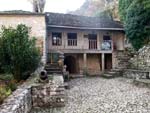  The island of Ioannina, in Pamvotis lake, is one of the most beautiful and picturesque places of Ioannina. It attracts tourists because, apart from its beauty, it has a rich historical and religious tradition.
It was a great religious and monastic center, which is testified by the surviving monasteries: The island of Ioannina, in Pamvotis lake, is one of the most beautiful and picturesque places of Ioannina. It attracts tourists because, apart from its beauty, it has a rich historical and religious tradition.
It was a great religious and monastic center, which is testified by the surviving monasteries:
Philanthropinon Monastery: It is one of the most important post-Byzantine monuments in Greece. The catholoc of the church was built in 1992 and is dedicated to Saint Nicholas. The representation of the ancient Greek philosophers at the temple is of a great interest (16th century).
Panteleimon Monastery: The monastery was founded in the 15th century. The church was renovated in the 19th century.
You can also visit the monasteries: Stratigopoulos Monastery, Eleoussa Monastery, Monastery of the Transfiguration of Christ.
See the cell, where Ali Pasha was murdered, that now operates as a museum of the pre-revolutionary period.
The link to the city of Ioannina is done by small boats from the jetty, a trip of less than ten minutes. The boats leave every hour from Ioannina and from the island.
In the island, you will taste lifelike fishes and eels you can fish on your own, and traditional foods. Specialty of the island is the frog-legs. |
 |
Wax Museum P. Vrellis |
|
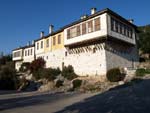 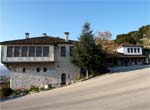 The Museum of Greek History is a work of Paul Vrellis. The artist graduated the sculpture department of the School of Fine Arts in 1954. The Museum of Greek History is a work of Paul Vrellis. The artist graduated the sculpture department of the School of Fine Arts in 1954.
At the age of 60 years, in 1983, he bought the land, where is now the museum, and after a 13 years of continuous work, has its current form.
By his own ideas, studies and of course a lot of personal work, he created areas and people to help the viewer to understand the events gone by. All themes are drawn from the Greek history. It is divided into three sections: Pro-revolution section, section of the revolution of 1821, section of the Second World War and ends with references and reminders.
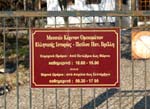 The first section includes the topics: The first section includes the topics:
• Secret School during the years of slavery..
• The martyrdom of philosopher Dionysius.
• Epirus Benefactors (Sinas George, Averoff George, Zosimas Anastasios, Zappas Konstantinos).
• Teachers of the Nation (Balanos Kosmas, Psalidas Athanasios).
• The Oath of the three men of Filiki Etairia.
• The Legendary Katsantonis.
• The enslave Hellenism in prison during the Turkish occupation.
• Velestinlis Rigas - Fereos.
• The bombing of the Church of Agia Paraskevi by the Samuel monk in Kougi.
• Etolos Kosmas.
• Partnership of "Kleftes" and "Armatoli" in one lair.
• The massacre of Ali Pasha in Ioannina Island. The lady Vasiliki is leaving to expatriate.
The section of the revolution of 1821 includes the topics:
• Makriyannis Ioannis.
• Warriors of 1821.
• Nikitaras Stamatelopoulos - Turk eater.
• Kolokotronis Theodoros.
• Kanaris Konstantinos.
• Kolokotronis Theodoros in prison of Nafplion.
• Macedonian Struggle - Melas Pavlos.
• First World War - Display of Bizanio forts.
The section of the Second World War includes the topics:
• Enemy helmets and loots - bitter memories of 1940-44.
• The Headquarters of the VIII Armored Division, in Kalpaki cave.
• Letter from a soldier from the war field of Albania.
• The women of Pindos.
• Observatory.
• Mountain Artillery.
• Mountain Surgery.
• German invasion at Eastern Macedonia. Forts of Rupel.
• Battle of Crete.
The last section with the reports and the reminders includes:
• Lady of Ro.
• German furnace.
• Report to the tragedy of Cyprus.
• Uprooting of Greeks from Asia Minor.
• Reference to Byzantium.
• Reference to Ancient Greece.
• The Artist's Workshop.
The Museum of Greek History - Wax models of Paul Vrellis is located in Bizani of Ioannina, 10 km from Ioannina (Ioannina - Athens). |
 |
Perama Cave of Ioannina |
|
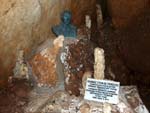 Very close to the town of Ioannina, in Perama (4 km), is one of the rarest caves in the world, the Cave of Perama.
It covers an area of 14.800 m², and is one of the largest terrestrial caves in Balkans. The length of the route is 1700 m., but the actual route for visitors is 1100 meters. Very close to the town of Ioannina, in Perama (4 km), is one of the rarest caves in the world, the Cave of Perama.
It covers an area of 14.800 m², and is one of the largest terrestrial caves in Balkans. The length of the route is 1700 m., but the actual route for visitors is 1100 meters.
It belongs to the karst limestone caves and consists of many chambers and corridors, which are connected and are adorned with stalactites, stalagmites and columns. We meet nineteen kinds of stalactites and stalagmites, while the other caves have up to six kinds.
Perama Cave was discovered accidentally in 1940 during the Second World War, as the residents were trying to find a refuge from bombing.
After the war, Kasvikis Constantinos, a trainer and an amateur caver, went to Perama, along with his team, in order to photograph it and he published the photographs in local and Athenian newspapers.
From this event, John and Anna Petrochilos learned about this cave and visited Perama and began a systematic exploration and mapping of the cave, so to develop tourist industry.
The tour in the cave is done in small groups of people
with an escort - guide.
|
|
 |
Accommodation and Entertainment proposals in the city of Ioannina |
|
|
|